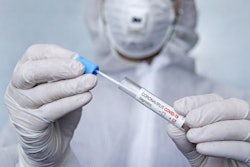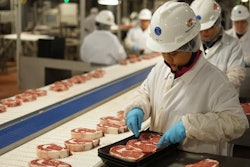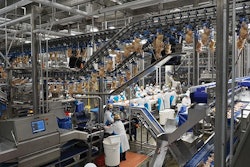
U.K. poultry producer Moy Park’s Ashbourne hatchery in Newark-upon-Trent, Lincolnshire, opened in 2017, becoming the U.K.’s biggest greenfield hatchery. It now produces 2.4 million chicks per week and uses some of the most advanced automation systems.
Dan Ashmore, Moy Park’s hatchery manager, talks to Jenny Hone about why, almost three years down the line, he is starting to feel “confident” about the site.
Hone: This was clearly a huge project. Was the hatchery completed on time?
Ashmore: It was an incredibly ambitious project and our opening day – September 4, 2017 – is a date forever etched in my memory!
As well as being the biggest single build hatchery in the U.K., the facility uses the most technologically advanced incubation and automation solutions, including camera chick counting technology and in line chick take off. The design also incorporates biosecurity features that were previously only used in our food production facilities. These include features such as shower in/shower out; hospital theatre grade air filtration; a sophisticated air distribution system that controls airflows throughout the hatchery; and anti-backflow drainage systems.
As this was an integrated project, as well as the hatchery, Moy Park also invested in new controlled environment chick delivery vehicles to ensure that the health and welfare of the chicks are optimized for the short journey from hatchery to farm. In all, this means we have a facility truly fit for the 2020s – entirely committed to the highest standards of incubation, biosecurity and animal welfare.
Despite facing many challenges through the design, build, and commissioning phases, we not only met our target completion date, but also the first hatching eggs were delivered that afternoon from Moy Park breeder farms and set for incubation the following day – on September 5. In all, it took about 53 weeks from the first sod being cut to our first eggs coming out.
Hone: A project this ambitious was bound to have had teething problems? Which one stands out for you?
Ashmore: If I had to pick one challenge it was tunneling under the A1 road to secure electricity, but our project team was truly multi skilled and we had solid relationships with our primary contractors. All milestones through this development were managed and met so well that ‘go live’ was distinctly uneventful.
Hone: Why build the U.K.’s biggest hatchery at Newark?
Ashmore: We chose Newark because of its central location – its access to major road networks makes it an ideal base from which to supply our grower base - we supply 60 farms across Lincolnshire - and it’s close to our processing plant in Anwick, which takes 80% of site output. We were lucky because there were no planning objections.
Hone: Does this site have the potential for expansion?
Ashmore: Yes, the hatchery has been operating for more than two years now and is working well – at high capacity and producing consistent returns – but there is the potential to expand capacity beyond the current 2.4 million chicks a week.
When designing the primary building within the site, consideration was given to ‘future proofing’ it for any potential expansion. There is sufficient land adjoining the hatchery building to allow additional setter halls and hatch rooms to be added to allow us to increase capacity by a further 50%.
Hone: What do you consider to be the main challenges facing the food production sector at present and how do you confront them?
Ashmore: Demand for our products remains strong across all regions and we have a strategic investment program that is built to foster growth.
The industry as a whole continues to face the challenge of meeting consumer expectations while also addressing their concerns on sustainability and the desire for healthy and convenient food choices.
Customers take it as a given that food safety and quality will always be there, but we invest time, energy, and resources to develop a culture to maintain these high standards. We continually challenge ourselves to innovate to help our customers stand out from the crowd.
For example, we are continually innovating within our product portfolio where we have a team of culinary chefs and insight analysts who help to bring the latest foodie trends from around the world to life in our products. We also focus on scientific and technical innovation, working with leading academic institutions to bring cutting-edge thinking to our ways of working within agriculture and food safety and this has resulted in us being an industry leader in terms of both antibiotic and Campylobacter reduction.
Two big areas we are looking at are focused around convenience and health. Neither of these mega trends is going away any time soon. Consumers are increasingly time pressured, so we are always looking for ways to give them that little helping hand, whether by preflavoring or marinating a product, working on optimum cooking times, or developing packaging solutions that make products easier to use.
Sustainability is a major focus for us as a business as well as for the agri-food sector in general and we continue to work closely with several bodies to support our strategy so that investment is directed where needed.
Hone: Has finding staff become more difficult with Brexit?
Ashmore: Securing experienced staff for the hatchery was a major obstacle. The majority of our new staff had not been in a hatchery before and, given the new nature of the site, those who had didn’t have any advantage.
To mitigate against these challenges, we set up a ‘Hatchery School’. It gave people training in incubation, hazard training, health and safety, hygiene and animal welfare as well as an induction into how the Moy Park business works.
Training is always ongoing. As a new site, it takes a lot longer than six months to settle in; I feel that now, almost three years later, we are much more comfortable and confident.
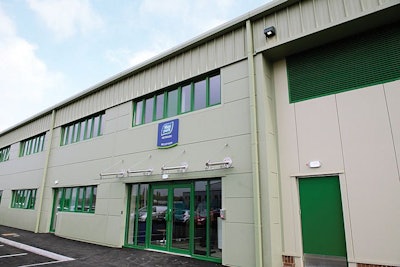
Bringing new staff on board required the establishment of a “Hatchery School”, teaching new staff not only about working in a hatchery but also how the Moy Park business works. | Courtesy Moy Park
Hone: How else do you feel Brexit may affect your business?
Ashmore: Our capital investment program hasn’t changed. We invested £45 million (US$55.3 million) last year and we are doing the same this year. With a deal in place, we are working through the detail ensuring we have access to the labor we need and how waste management and transportation will work in practice.
Hone: How will the hatchery achieve net-zero greenhouse gas emissions by 2040?
Ashmore: The hatchery is hugely efficient already. It utilizes the latest automation techniques and energy-efficient equipment, reducing electrical energy usage by 25%. We’ll continue to look at technology and waste solutions to meet the target.
Hone: Is there anything about this project you are particularly proud of?
Ashmore: A standout memory of the whole project for me is the comradeship it brought about. It was a visionary build and working together with all our partners we came up with creative solutions to make it happen. I was thrilled the site won ‘Hatchery of the Year’ at the National Egg and Poultry Awards in 2019 – it’s a testament to the hard work of everyone involved.
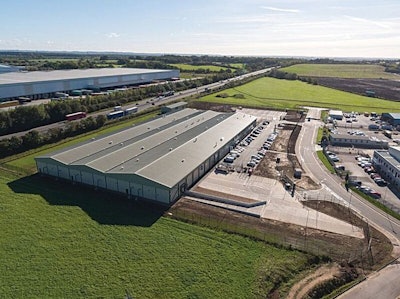
Construction of the “incredibly ambitious” was well managed. Now running for close to three years, the facility has the potential to be expanded by 50%. | Courtesy Moy Park
Moy Park opens UK’s largest single-build hatchery


